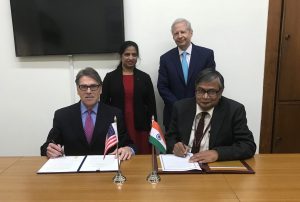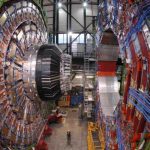Fermilab is developing and testing a revolutionary particle detector concept, one that will enable the CMS detector at CERN’s Large Hadron Collider to handle 10 times the number of particle collisions currently being produced at the European machine — a virtual avalanche. This upgrade will make the LHC the world’s highest-energy proton smasher in the next decades.
At the LHC, two beams of protons are accelerated to nearly the speed of light around the collider’s 18-mile ring in opposite directions, colliding inside one of four detectors, including one called CMS. The protons smash together in the detector’s core, producing a plethora of subatomic particles that fly off in all directions.
The detector — a gigantic, barrel-shaped device that could surround a whale if the instrument were hollow — is packed with layers of detectors that surround the collision site. Think of it as a superhigh-tech onion — a 14,000-ton onion equipped with billions of sensors in its core, buried 100 meters underground. These layers collect data from the particles emerging from the collisions, tracking their paths as they shoot away from the center.
Higher luminosity for the Higgs
In the late 2020s, CERN will turn up the LHC’s beam luminosity, or the number of protons packed into its beams, resulting in showers of even more particles. This increased abundance will give scientists more opportunities to reveal new particles and processes, helping us refine our understanding of how the universe works.
The CMS and ATLAS co-discovered the Higgs boson in 2012, a discovery that led to a Nobel Prize. Now, both experiments are working to learn more about the Higgs and how it behaves — and in the process to maybe reveal something unexpected.
“There’s the possibility of not only making very precise measurements of phenomena that will allow us to test our assumptions about the Standard Model, but also gaining an increased scope for new physics that might be just beyond where we’re reaching now,” said Ron Lipton, a Fermilab scientist on the CMS experiment who is coordinating the detector project at national level.
Of course, the LHC’s high luminosity won’t do much good if the detector isn’t equipped to handle it.
To take advantage of the more prolific collisions — the LHC will produce 40 million particle beam collisions every second — Fermilab scientists and engineers partnered with other CMS collaborators on a new design for components of the CMS detector, enabling it to respond more quickly to the expected particle fusillade. And these components lie at the heart of CMS.
Some of the CMS detector’s most valuable players in detecting and tracking particles are instruments nestled among its the innermost layers. The devices are called tracking modules.
Tracking modules are positioned in shells around the collision site, so they catch most particles flying away from it as they pass through consecutive layers. Together, the modules reconstruct the particles’ trajectories from individual position measurements.
Each module is about the size of your hand and made of two thin, flat silicon layers that lie on top of each other, separated by a few millimeters — a slim, silicon sandwich. Both the silicon layers and their attached chips are made of lightweight material, so they have negligible influence on the path of particles passing through them. Although delicate in appearance, they are durable enough to stand up to the particles bombarding them.
Each silicon layer is made of pixels like those in a digital camera’s sensor. They create refined 3-D images of a particle’s path with lightning-fast shutter speed. About 13,000 new modules in the tracker will together be made of nearly 30 times as many pixels as the current CMS setup, for a total of almost 300 million pixels. Just as with your camera, more and smaller pixels lead to more distinct images. (The average digital camera has around 12 million pixels.)
The modules’ design is also highly innovative: A particle first passes through one silicon sensor, and then the other, mere millimeters away. A single readout chip correlates both sensors’ measurements, selecting signals from only the most energetic particles for further analysis.
The demand on these chips, processing data 40 million times per second — nearly 1 million times higher than in an LCD TV monitor — has never been higher. The boost in processing speed enables CMS to capture and store many more particle collision images at once.
“These are very complex modules to build compared to previous experiments — they’re a novel design, and they will enable CMS to exploit the discovery potential of the machine,” said Fermilab scientist Anadi Canepa.
These intelligent modules simultaneously process and sift through the overwhelming amount of data, singling out interesting events — such as the production of a Higgs boson or supersymmetric particle — close to the collision site rather than processing it from afar, a situation that clogs the pipes with data, so to speak.
“The more collisions you manage to store, the higher the probability that you’ll see a very rare event happen — the kind that scientists see only once in billions of collisions,” Canepa said.
The high-luminosity LHC
The upcoming high-luminosity run will be the LHC’s longest yet. By the end, in the mid-2030s, the LHC will have collected 120 times more data than any previous run.
More data also mean more accurate measurements of particle properties, such as the different ways a particle can decay. This is especially important for rare particles whose behavior has yet to be fully explored, such as the Higgs boson.
“We want to improve our knowledge of the Higgs boson, so we need a lot of data, because the more data you have, the better your precision for a given measurement,” Canepa said.
Fermilab is currently prototyping the tracking modules. Scientists, engineers and technicians have first built small models, called minimodules, similar to those they will eventually install in the detector, and run them through a test beam to make sure they are durable enough to stand up to the LHC’s future high luminosity. They have also just completed the assembly of the first U.S. full-size, functional module. Collaborators at Brown, Princeton and Rutgers universities are building the modules as well, in addition to other detector components.
Fermilab plans to build roughly 3,000 modules, and the installation of the modules and other components is scheduled to begin at CERN in the mid-2020s.
The tracking modules are the first in a series of CMS upgrades in which Fermilab plays a key role. The lab will also be responsible for building components that measure the energy of the postcollision particles, detect their arrival times and help single out significant events from the ordinary ones.
They will be ready in time for the LHC’s high-luminosity beams, which we can expect to speed around that 18-mile ring in 2026.
Fermilab offers several annual traditions for our neighbors, from our Family Open House to our STEM Career Expo. But none are quite as anticipated as the birth of the year’s first baby bison.
On Wednesday, April 18, baby bison season officially began. The first calf of the year was born in the early morning hours, with a second appearing before noon. The first two baby bison calves are healthy and keeping up with their mothers, walking and nursing.
Fermilab is expecting between 10 and 14 new calves this spring, and all of our neighbors are welcome to come on site to visit with and photograph the newborns. (They are always a hit with young children.) The Fermilab site is open every day from 8 a.m. to 8 p.m., and admission is free. You’ll need a valid photo ID to enter the site.
Fermilab’s first director, Robert Wilson, established the bison herd in 1969 as a symbol of the history of the Midwestern prairie and the laboratory’s pioneering research at the frontiers of particle physics. The herd remains a major attraction for families and wildlife enthusiasts.
And thanks to the science of genetic testing, Fermilab’s ecologist confirmed that the laboratory’s herd shows no evidence of cattle gene mixing. Farmers during the early settlement era would breed bison with cattle in an attempt to create more tame bison or more hardy cattle.
A herd of bison is a natural fit for a natural laboratory. Fermilab hosts nearly 1,000 acres of reconstructed tallgrass prairie, as well as remnant oak savannas, marshes and forests.
While you’re at the Fermilab site visiting the bison, you can learn more about our ecological efforts by hiking the Interpretive Prairie Trail, a half-mile-long trail located near the Pine Street entrance in Batavia. The Lederman Science Center also offers exhibits on the prairie and hands-on physics displays. The Lederman Center hours are Monday-Friday from 8:30 a.m. to 4:30 p.m. and Saturdays from 9 a.m. to 3 p.m. And the 15th floor of Wilson Hall is open to the public Monday-Friday from 8 am to 4:30 p.m. and Saturdays and Sundays from 9 a.m. to 3 p.m.
For up-to-date information for visitors, please visit www.fnal.gov or call 630-840-3351. To learn more about Fermilab’s bison herd, please visit the wildlife area of our website.
Fermilab is America’s premier national laboratory for particle physics and accelerator research. A U.S. Department of Energy Office of Science laboratory, Fermilab is located near Chicago, Illinois, and operated under contract by the Fermi Research Alliance LLC, a joint partnership between the University of Chicago and the Universities Research Association, Inc. Visit Fermilab’s website at www.fnal.gov and follow us on Twitter at @Fermilab.
The DOE Office of Science is the single largest supporter of basic research in the physical sciences in the United States and is working to address some of the most pressing challenges of our time. For more information, please visit science.energy.gov.

U.S. Secretary of Energy Rick Perry, left, and Indian Atomic Energy Secretary Sekhar Basu, right, signed an agreement on Monday in New Delhi, opening the door for continued cooperation on neutrino research in both countries. In attendance were Hema Ramamoorthi, chief of staff of the U.S. DOE’s Fermi National Accelerator Laboratory, and U.S. Ambassador to India Kenneth Juster. Photo courtesy of Fermilab
This release was originally issued today by the U.S. Department of Energy.
Earlier today, April 16, 2018, U.S. Secretary of Energy Rick Perry and India’s Atomic Energy Secretary Dr. Sekhar Basu signed an agreement in New Delhi to expand the two countries’ collaboration on world-leading science and technology projects. It opens the way for jointly advancing cutting-edge neutrino science projects underway in both countries: the Long-Baseline Neutrino Facility (LBNF) with the international Deep Underground Neutrino Experiment (DUNE) hosted at the U.S. Department of Energy’s Fermilab and the India-based Neutrino Observatory (INO).
LBNF/DUNE brings together scientists from around the world to discover the role that tiny particles known as neutrinos play in the universe. More than 1,000 scientists from over 170 institutions in 31 countries work on LBNF/DUNE and celebrated its groundbreaking in July 2017. The project will use Fermilab’s powerful particle accelerators to send the world’s most intense beam of high-energy neutrinos to massive neutrino detectors that will explore their interactions with matter.
INO scientists will observe neutrinos that are produced in Earth’s atmosphere to answer questions about the properties of these elusive particles. Scientists from more than 20 institutions are working on INO.
“The LBNF/DUNE project hosted by the Department of Energy’s Fermilab is an important priority for the DOE and America’s leadership in science, in collaboration with our international partners,” said Secretary of Energy Rick Perry. “We are pleased to expand our partnership with India in neutrino science and look forward to making discoveries in this promising area of research.”
Scientists from the United States and India have a long history of scientific collaboration, including the discovery of the top quark at Fermilab.
“India has a rich tradition of discoveries in basic science,” said Atomic Energy Secretary Basu. “We are pleased to expand our accelerator science collaboration with the U.S. to include the science for neutrinos. Science knows no borders, and we value our Indian scientists working hand-in-hand with our American colleagues. The pursuit of knowledge is a true human endeavor.”
This DOE-DAE agreement builds on the two countries’ existing collaboration on particle accelerator technologies. In 2013, DOE and DAE signed an agreement authorizing the joint development and construction of particle accelerator components in preparation for projects at Fermilab and in India. This collaborative work includes the training of Indian scientists in the United States and India’s development and prototyping of components for upgrades to Fermilab’s particle accelerator complex for LBNF/DUNE. The upgrades, known as the Proton Improvement Plan-II (PIP-II), include the construction of a 600-foot-long superconducting linear accelerator at Fermilab. It will be the first ever particle accelerator built in the United States with significant contributions from international partners, including also the UK and Italy. Scientists from four institutions in India – BARC in Mumbai, IUAC in New Delhi, RRCAT in Indore and VECC in Kolkata – are contributing to the design and construction of magnets and superconducting particle accelerator components for PIP-II at Fermilab and the next generation of particle accelerators in India.
Under the new agreement signed today, U.S. and Indian institutions will expand this productive collaboration to include neutrino research projects. The LBNF/DUNE project will use the upgraded Fermilab particle accelerator complex to send the world’s most powerful neutrino beam 800 miles (1,300 kilometers) through the earth to a massive neutrino detector located at Sanford Underground Research Facility in South Dakota. This detector will use almost 70,000 tons of liquid argon to detect neutrinos and will be located about a mile (1.5 kilometers) underground; an additional detector will measure the neutrino beam at Fermilab as it leaves the accelerator complex. Prototype neutrino detectors already are under construction at the European research center CERN, another partner in LBNF/DUNE.
“Fermilab’s international collaboration with India and other countries for LBNF/DUNE and PIP-II is a win-win situation for everybody involved,” said Fermilab Director Nigel Lockyer. “Our partners get to work with and learn from some of the best particle accelerator and particle detector experts in the world at Fermilab, and we benefit from their contributions to some of the most complex scientific machines in the world, including LBNF/DUNE and the PIP-II accelerator.”
INO will use a different technology — known as an iron calorimeter — to record information about neutrinos and antineutrinos generated by cosmic rays hitting Earth’s atmosphere. Its detector will feature what could be the world’s biggest magnet, allowing INO to be the first experiment able to distinguish signals produced by atmospheric neutrinos and antineutrinos. The DOE-DAE agreement enables U.S. and Indian scientists to collaborate on the development and construction of these different types of neutrino detectors. More than a dozen Indian institutions are involved in the collaboration on neutrino research.
Additional quotes:
Prof. Vivek Datar, INO spokesperson and project director, Taha Institute of Fundamental Research:
“This will facilitate U.S. participation in building some of the hardware for INO, while Indian scientists do the same for the DUNE experiment. It will also help in building expertise in India in cutting-edge detector technology, such as in liquid-argon detectors, where Fermilab will be at the forefront. At the same time we will also pursue some new ideas.”
Prof. Naba Mondal, former INO spokesperson, Saha Institute of Nuclear Physics:
“This agreement is a positive step towards making INO a global center for fundamental research. Students working at INO will get opportunities to interact with international experts.”
Prof. Ed Blucher, DUNE co-spokesperson, University of Chicago, United States:
“The international DUNE experiment could fundamentally change our understanding of the universe. Contributions from India and other partner countries will enable us to build the world’s most technologically advanced neutrino detectors as we aim to make groundbreaking discoveries regarding the origin of matter, the unification of forces, and the formation of neutron stars and black holes.”
Prof. Stefan Soldner-Rembold, DUNE co-spokesperson, University of Manchester, UK:
“DUNE will be the world’s most ambitious neutrino experiment, driven by the commitment and expertise of scientists in more than 30 countries. We are looking forward to the contributions that our colleagues in India will make to this extraordinary project.”
To learn more about LBNF/DUNE, visit www.fnal.gov/dunemedia. More information about PIP-II is available at pip2.fnal.gov.
Fermilab is America’s premier national laboratory for particle physics and accelerator research. A U.S. Department of Energy Office of Science laboratory, Fermilab is located near Chicago, Illinois, and operated under contract by the Fermi Research Alliance LLC, a joint partnership between the University of Chicago and the Universities Research Association, Inc. Visit Fermilab’s website at www.fnal.gov and follow us on Twitter at @Fermilab.
The DOE Office of Science is the single largest supporter of basic research in the physical sciences in the United States and is working to address some of the most pressing challenges of our time. For more information, please visit science.energy.gov.
:



